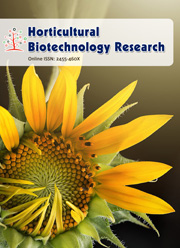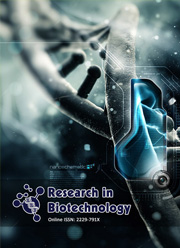A comparative method for protein extraction and proteome analysis by two-dimensional gel electrophoresis from banana fruit
DOI:
https://doi.org/10.19071/jhcbt.2016.v2.3049Abstract
Bananas and plantains are a major staple food and export product in many countries. Banana fruit tissues contain large amounts of secondary compounds, polysaccharides and other plant polymers which will interfere with protein extraction for gel-based proteomic analysis. Due to presence of very small amount of proteins (approximately 1%) in a large matrix of fruit tissues, it classified as ‘recalcitrant’. In this connection, assessment of different protein extraction protocols and extraction of high quality proteins from banana fruit tissues is crucial for successful gel-based proteome analysis.  In this study, two different protein extraction protocols were validated to isolate proteins from banana (cv.Grand Naine) fruit peel and pulp tissues, and proteins were resolved by using SDS-PAGE.  A comparative study showed that phenol based method is effective in extracting proteins over TCA-acetone method. Isolated proteins were further subjected to two-dimensional gel electrophoresis separation and stained with colloidal coomassie blue to visualize protein spots. On average 380 protein spots could be detected on coomassie stained two-dimensional gel and our study clearly demonstrated the differential protein accumulation during pre-climacteric and climacteric stages of banana fruit.Â
Downloads
References
Ambrosioa CD, Arena S, Roccob M, Verrillo F, Novi G, Viscosi V, Marrad M, Scaloni A. Proteomic analysis of apricot fruit during ripening. Journal of Proteomics 2013; 78: 39-57.
Andrade JM, Toledoa TT, Nogueira SB, Cordenunsi BR, Lajoloa FM, Nascimentoa JRO. 2D-DIGE analysis of mango (Mangifera indica L.) fruit reveals major proteomic changes associated with ripening. Journal of Proteomics 2012; 75: 3331-3341.
Carpentier SB, Witters E, Laukens K, Deckers P, Swennen R, Panis B. Preparation of protein extracts from recalcitrant plant tissues: an evaluation of different methods for two-dimensional gel electrophoresis analysis. Proteomics 2005; 5:2497–2507.
Carpentier SC, Witters E, Laukens K, Van Onckelen H, Swennen R, Panis B.. Banana (Musa spp.) as a model to study the meristem proteome: acclimation to osmotic stress. Proteomics 2007 ; 1: 92-105.
Cottrell JS. Protein identification using MS/MS data. J. Proteomics 2011; 74: 1842–1851.
Damerval C, De Vienne D, Zivy M, Thiellement H. Technical improvements in two-dimensional electrophoresis increase the level of genetic variation detected in wheat-seedling proteins. Electrophoresis 1986; 7: 52–54.
Dominguez-Puigjaner E, Vendrell M, Ludevid MD. Differential protein accumulation in banana fruit during ripening. Plant Physiology 1992; 98: 157–162.
Esteve C, D’Amato A, Marina ML, Garc´ıa MC, Righetti PG. In-depth proteomic analysis of banana (Musa spp.) fruit with combinatorial peptide ligand libraries. Electrophoresis 2013; 34: 207–214.
FAOSTAT. Data base. Available from: http://www.faostat3.fao.org/; 2011.
Hurkman WJ, Tanaka CK.. Solubilization of plant membrane proteins for analysis by two-dimensional gel. Plant Physiol 1986; 81: 802–806.
JorrÃn JV, Maldonado AM, Castillejo MA. Plant proteome analysis: a 2006 update. Proteomics 2007; 7(16): 2947–2962.
JorrÃn-Novo JV, Maldonado AM, EchevarrÃa-Zomeño S, Valledor L, Castillejo MA, Curto M, Valero J, Sghaier B, Donoso G, Redondo I. Plant proteomics update (2007–2008): second-generation proteomic techniques, an appropriate experimental design, and data analysis to fulfill MIAPE standards, increase plant proteome coverage and expand biological knowledge. J. Proteomics 2009; 72(3): 285–314.
Lu Y, Qi YX, Zhang H, Zhang HQ, Pu JJ, Xie YX. Separation and identification of Musa acuminate Colla (banana) leaf proteins by two-dimensional gel electrophoresis and mass spectrometry. Genetics and Molecular Research 2013; 12 (4): 6871-6881.
Nilo R, Saffie C, Lilley K, Baeza-Yates R, Cambiazo V, Campos-Vargas R, González M, Meisel LA, Retamales J, Silva H, Orellana A. Proteomic analysis of peach fruit mesocarp softening and chilling injury using difference gel electrophoresis (DIGE). BMC Genomics 2010; 11:43.
Righetti PG, Esteve C, D’Amato A, Fasoli E, Marina ML, Garc´ıa MC. A sarabande of tropical fruit proteomics: Avocado, banana, and mango. Proteomics 2015; 15: 1639-1645.
Rose JKC, Bashir S, Giovannoni, Jahn MM, Saravanan RS. Tackling the plant proteome: practical approaches, hurdles and experimental tools. The Plant Journal 2004; 39: 715-733.
Samyn B, Sergeant K, Carpentier S, Debyser G, Panis B, Swennen R, Van Beeumen J.. Functional proteome analysis of the banana plant (Musa spp.) using de novo sequence analysis of derivatized peptides. J. Proteome Res 2007; 6(1): 70-80.
Santoni V, Delarue M, Caboche M, Bellini C. A comparison of two dimensional electrophoresis data with phenotypical traits in Arabidopsis leads to the identification of a mutant(cri1) that accumulates cytokinins. Planta 1997; 202: 62–69.
Saravanan RS, Rose JK. A critical evaluation of sample extraction techniques for enhanced proteomic analysis of recalcitrant plant tissues. Proteomics 2004. 4: 2522–2532.
Sebastiana M, Figueiredo A, Monteiro F, Martins J, Franco C, Coelho AV, Vaz F, Simões T, Penque D, Pais MS, Ferreira S.. A possible approach for gel-based proteomic studies in recalcitrant woody plants. SpringerPlus 2013; 2: 210.
Singh N, Jain N, Kumar R, Jain A, Singh NK, Rai V.. A comparative method for protein extraction and 2-D gel electrophoresis from different tissues of Cajanus cajan. Front. Plant Sci 2015; 6: 606.
Stalikas CD. Extraction, separation, and detection methods for phenolic acids and flavonoids. J. Sep. Sci. 2007; 30: 3268-3295.
Toledo TT, Nogueira SB, Cordenunsi BR, Gozzo FC, Pilau EJ, Lajolo FM. Oliveira do Nascimento JR. Proteomic analysis of banana fruit reveals proteins that are differentially accumulated during ripening. Postharvest Biol. Tec. 2012; 70: 51–58.
Vaganan MM, Sarumathi S, Nandakumar A, Ravi I, Mustaffa MM. Evaluation of different protein extraction methods for banana (Musa spp.) root proteome analysis by two-dimensional electrophoresis. Indian Journal of Biochemistry & Biophysics 2015; 52: 101-106.
Vertommen A, Møller AL, Cordewener JH, Swennen R, Panis B, Finnie C, America AH, Carpentier SC. A workflow for peptide-based proteomics in a poorly sequenced plant: a case study on the plasma membrane proteome of banana. J. Proteomics 2011; 74(8): 1218-1229.
Wang W, Tai F, Chen S. Optimizing protein extraction from plant tissues for enhanced proteomics. J. Sep .Sci. 2008; 31(11): 2032–2039.
Wang W, Vignani R, Scali M, Cresti M. A universal and rapid protocol for protein extraction from recalcitrant plant tissues for proteomic analysis. Electrophoresis 2006; 27(13): 2782–2786.
Wang W, Scali M, Vignani R, Spadafora A, Sensi E, Mazzuca S, Cresti M. Protein extraction for two-dimensional electrophoresis from olive leaf, a plant tissue containing high levels of interfering compounds. Electrophoresis 2003; 24:2369–2375.
Witzel K, Surabhi GK, Kumari GJ, Sudhakar C, Matros A, Mock H-P. Quantitative proteome analysis of barley seeds using ruthenium(II)-tris-(bathophenanthroline-disulphonate) staining. Journal of Proteome Research 2007; 6 (4): 1325-1333.
Wu X, Xiong E, Wang W, Scali M, Cresti M. Universal sample preparation method integrating trichloroacetic acid/acetone precipitation with phenol extraction for crop proteomic analysis. Nature Protocols 2014; 9: 362-374.



 .
.